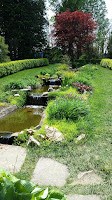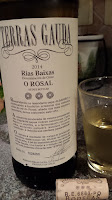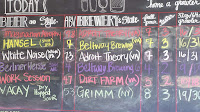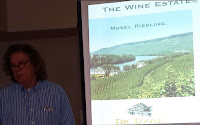The Mosel Valley is one of the few areas where phylloxera won't survive in its porous sandy soils. Thus vines are planted "ungrafted" on original rootstock. And many of these ungrafted vines are well over 100 years old. These were a few of the many facts I learned from Ernst Loosen during a recent Dry Riesling seminar at
Cork Wine Bar. During this event, the popular and influential owner of Germany's
Dr. Loosen winery discussed his family's history, the topography of Mosel as well as Pfalz (home to his
Villa Wolf brand) and poured many delicious dry Rieslings.
In the Mosel Valley, vineyards are generally steep, south facing, and in many cases comprised of red or blue slate soils. Ernst spent considerable time discussing these slate soils -- particularly with a map displaying vineyards by soil type. Besides being well drained and nutrient poor (forcing the roots to dig deep), the slate also radiates heat creating mini micro-climates. The vineyards are also protected from "foul" weather drifting over from France by the Rhenish-Westphalian Slate Mountains. And as stipulated by an edict from the 1700s, only Riesling can be grown in the Mosel Valley.
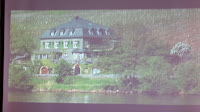
Ernst also discussed the Dr. Loosen pedigree as the estate has been in the same family for 200 years. His grandparents had two separate estates and these were joined by marriage with the current winery coming from his grandmother's holdings. Interestingly one side of the family only produced dry Rieslings whereas the other only sweeter versions. Today, the winery's six major vineyards are designated as “Erste Lage” -- equivalent to grand cru -- as designated in the 1868 Prussian classification of Mosel vineyards. Wines from these estates are designated single-vineyard whereas all other Dr. Loosen wines are labeled as estate wines.

Ernst also stressed how Dr. Loosen Rieslings can age, both in the bottle as well as in the large oak casks used for fermenting and aging. In fact, through a friend of his grandfather's he learned about a method of extreme aging.. He conducted his own experiment and by creating a reductive environment with continual topping off and making sure the yeast were still active, he was able to validate that a wine could age 17 years in cask was still by lively and vibrant. The extended maturation in the cask, on full lees, stabilizes the wine naturally and provides time for it to develop structure and deeper complexity. Seventeen years is by no means a standard practice but they do age most of their Rieslings on the lees for at least a year -- and usually for two.
2014 Dr. Loosen Riesling Dry ($12)
This is the winery's entry level wine made from contracted fruit that Dr. Loosen's vineyard manager oversees. Most of these vineyards reside in blue slate soils. For such an inexpensive wine there is a pronounced floral aroma, a touch of minerals and racy acids.
2014 Dr. Loosen “Red Slate” Riesling Dry ($18)
This wine is made from red slate estate vineyards in Erden and
Ürzig and fermented on its less for 12 months in the 3,000-liter oak casks. This is a richer, rounder, and more elegant wine, with intense minerals that compliment the citrus profile. The finish is more subdued but plenty refreshing.
2013 Wehlener Sonnenuhr (The Sundial of Wehlen) Riesling GG Alte Reben ($54)
This single vineyard GG wine comes from the steep and rocky blue slate vineyard
(VAY-len-er ZON-en-ooer) where the vines are well over 100 years old. The wine is fermented and aged in traditional 1,000-liter Fuder casks on less for one year. The result is a full bodied, yet feminine wine showing more apple over citrus and still plenty of acids for a refreshing finish. Ernst refers to this wine as a graceful
ballet dancer.
2012 Erdener Treppchen (The Little Staircase of Erden) Riesling GG Alte Reben ($54)
Long ago, in order to tend the vines, workers built stone steeps into the hillside of this red slate vineyard. Ernst referred to this wine as a "mountain climber", not only referencing the stone steps, but also because it is a muscular wine - complex and intense. There is also a considerable mineral content - almost minty in flavor that helps transition the wine from its wet stone aroma to the finish.
2013 Ürziger Würzgarten (The Spice Garden of Ürzig) Riesling GG Alte Reben ($54)
The steep Ürziger
Würzgarten (ERTS-ih-ger VERTS-gar-ten) vineyard was planted in red volcanic soil over 100+ years ago. Like the other GG wines, this one is fermented and aged in Fuder cask for one year before bottling. The herbal aroma is overpowering with the palate exploding with tropical and mineral driven flavors. Another intense offering.
2012 Ürziger Würzgarten (The Spice Garden of Ürzig) Riesling GG Alte Reben Reserve ($92)
This reserve wine is the same fruit from the previous wine, but kept in oak for 24 months and then aged a year in the bottle before release. Whereas the GG version was intense, this wine is smooth and elegant - almost delicate. The acids are soft, but still refreshing. Fantastic.
 One of the most reliable sources for affordable New Zealand Sauvignon Blanc has always been Villa Maria and they didn't disappoint with their current summer offerings tasted through the #FirstSipNZ campaign. Elizabeth Smith has the details on this campaign at Villa Maria’s First Sip of Summer. In general New Zealand, and in particular, Marlborough Sauvignon Blanc wines are fresh; driven by citrus, tropical, herbaceous, and mineral characteristics; and refreshingly acidic. I learned that the "minerality often comes from vineyards with stony old riverbed vineyard sites". Here are the two wines we sampled, both will be available across the U.S. either now or towards August. Cheers.
One of the most reliable sources for affordable New Zealand Sauvignon Blanc has always been Villa Maria and they didn't disappoint with their current summer offerings tasted through the #FirstSipNZ campaign. Elizabeth Smith has the details on this campaign at Villa Maria’s First Sip of Summer. In general New Zealand, and in particular, Marlborough Sauvignon Blanc wines are fresh; driven by citrus, tropical, herbaceous, and mineral characteristics; and refreshingly acidic. I learned that the "minerality often comes from vineyards with stony old riverbed vineyard sites". Here are the two wines we sampled, both will be available across the U.S. either now or towards August. Cheers. 


























